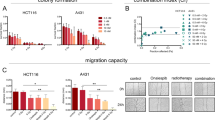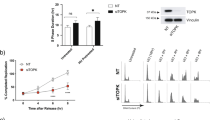Abstract
P53 wild-type and p53-null or mutant cells undergo a G2-phase cell-cycle arrest in response to ionizing radiation (IR). In this study we examined the effect of heat-shock protein 90 (HSP90) inhibitor, geldanamycin (GA), on IR-induced G2 arrest in human colon adenocarcinoma cells with different p53 status. We show that GA treatment abrogates IR-induced G2-phase arrest in cells null or mutant for p53. Specifically, GA treatment pushed irradiated p53 signaling-defective cells into a premature mitosis characterized by aberrant mitotic figures, increased γH2AX expression and formation of micronucleated cells. Cells expressing wild-type p53 were resistant to GA-induced G2 checkpoint abrogation. Notably, GA treatment decreased levels of G2 regulatory proteins Wee1 and Chk1, and inhibitory phosphorylation of Cdc2, independent of p53 status. Further investigation identified p21 as the potential downstream effector of p53 that mediates resistance to G2 checkpoint abrogation. Clonogenic survival studies demonstrated higher sensitivity to GA alone or combination IR plus GA treatment in p53 and p21-null cells. Collectively, these data demonstrate potential mechanisms through which HSP90 inhibition can enhance the effects of ionizing radiation in p53-compromised cancer cells. Combination IR plus HSP90 inhibitor therapies may be particularly useful in treating cancers that lack wild-type p53.
This is a preview of subscription content, access via your institution
Access options
Subscribe to this journal
Receive 50 print issues and online access
$259.00 per year
only $5.18 per issue
Buy this article
- Purchase on Springer Link
- Instant access to full article PDF
Prices may be subject to local taxes which are calculated during checkout







Similar content being viewed by others
References
Arlander SJ, Eapen AK, Vroman BT, McDonald RJ, Toft DO, Karnitz LM . (2003). Hsp90 inhibition depletes Chk1 and sensitizes tumor cells to replication stress. J Biol Chem 278: 52572–52577.
Banerji U, O’Donnell A, Scurr M, Pacey S, Stapleton S, Asad Y et al. (2005). Phase I pharmacokinetic and pharmacodynamic study of 17-allylamino, 17-demethoxygeldanamycin in patients with advanced malignancies. J Clin Oncol 23: 4152–4161.
Bisht KS, Bradbury CM, Mattson D, Kaushal A, Sowers A, Markovina S et al. (2003). Geldanamycin and 17-allylamino-17-demethoxygeldanamycin potentiate the in vitro and in vivo radiation response of cervical tumor cells via the heat shock protein 90-mediated intracellular signaling and cytotoxicity. Cancer Res 63: 8984–8995.
Bull EE, Dote H, Brady KJ, Burgan WE, Carter DJ, Cerra MA et al. (2004). Enhanced tumor cell radiosensitivity and abrogation of G2 and S phase arrest by the Hsp90 inhibitor 17-(dimethylaminoethylamino)-17-demethoxygeldanamycin. Clin Cancer Res 10: 8077–8084.
Bunz F, Dutriaux A, Lengauer C, Waldman T, Zhou S, Brown JP et al. (1998). Requirement for p53 and p21 to sustain G2 arrest after DNA damage. Science 282: 1497–1501.
Burma S, Chen BP, Murphy M, Kurimasa A, Chen DJ . (2001). ATM phosphorylates histone H2AX in response to DNA double-strand breaks. J Biol Chem 276: 42462–42467.
Castedo M, Perfettini JL, Roumier T, Andreau K, Medema R, Kroemer G . (2004). Cell death by mitotic catastrophe: a molecular definition. Oncogene 23: 2825–2837.
Deng C, Zhang P, Harper JW, Elledge SJ, Leder P . (1995). Mice lacking p21CIP1/WAF1 undergo normal development, but are defective in G1 checkpoint control. Cell 82: 675–684.
Dixon H, Norbury CJ . (2002). Therapeutic exploitation of checkpoint defects in cancer cells lacking p53 function. Cell Cycle 1: 362–368.
Dote H, Burgan WE, Camphausen K, Tofilon PJ . (2006). Inhibition of hsp90 compromises the DNA damage response to radiation. Cancer Res 66: 9211–9220.
Giono LE, Manfredi JJ . (2006). The p53 tumor suppressor participates in multiple cell cycle checkpoints. J Cell Physiol 209: 13–20.
Goes FS, Martin J . (2001). Hsp90 chaperone complexes are required for the activity and stability of yeast protein kinases Mik1, Wee1 and Swe1. Eur J Biochem 268: 2281–2289.
Grem JL, Morrison G, Guo XD, Agnew E, Takimoto CH, Thomas R et al. (2005). Phase I and pharmacologic study of 17-(allylamino)-17-demethoxygeldanamycin in adult patients with solid tumors. J Clin Oncol 23: 1885–1893.
Iliakis G, Wang Y, Guan J, Wang H . (2003). DNA damage checkpoint control in cells exposed to ionizing radiation. Oncogene 22: 5834–5847.
Inoue T, Geyer RK, Howard D, Yu ZK, Maki CG . (2001). MDM2 can promote the ubiquitination, nuclear export, and degradation of p53 in the absence of direct binding. J Biol Chem 276: 45255–45260.
Jackson JR, Gilmartin A, Imburgia C, Winkler JD, Marshall LA, Roshak A . (2000). An indolocarbazole inhibitor of human checkpoint kinase (Chk1) abrogates cell cycle arrest caused by DNA damage. Cancer Res 60: 566–572.
Jascur T, Brickner H, Salles-Passador I, Barbier V, El Khissiin A, Smith B et al. (2005). Regulation of p21(WAF1/CIP1) stability by WISp39, a Hsp90 binding TPR protein. Mol Cell 17: 237–249.
Jonathan EC, Bernhard EJ, McKenna WG . (1999). How does radiation kill cells? Curr Opin Chem Biol 3: 77–83.
Kamal A, Thao L, Sensintaffar J, Zhang L, Boehm MF, Fritz LC et al. (2003). A high-affinity conformation of Hsp90 confers tumour selectivity on Hsp90 inhibitors. Nature 425: 407–410.
Kastan MB, Zhan Q, El-Deiry WS, Carrier F, Jacks T, Walsh WV et al. (1992). A mammalian cell cycle checkpoint pathway utilizing p53 and GADD45 is defective in ataxia-telangiectasia. Cell 71: 587–597.
Kawabe T . (2004). G2 checkpoint abrogators as anticancer drugs. Mol Cancer Ther 3: 513–519.
Limoli CL, Kaplan MI, Corcoran J, Meyers M, Boothman DA, Morgan WF . (1997). Chromosomal instability and its relationship to other end points of genomic instability. Cancer Res 57: 5557–5563.
Marder BA, Morgan WF . (1993). Delayed chromosomal instability induced by DNA damage. Mol Cell Biol 13: 6667–6677.
Morgan WF . (2003a). Non-targeted and delayed effects of exposure to ionizing radiation: I. Radiation-induced genomic instability and bystander effects in vitro. Radiat Res 159: 567–580.
Morgan WF . (2003b). Non-targeted and delayed effects of exposure to ionizing radiation: II. Radiation-induced genomic instability and bystander effects in vivo, clastogenic factors and transgenerational effects. Radiat Res 159: 581–596.
Noguchi M, Yu D, Hirayama R, Ninomiya Y, Sekine E, Kubota N et al. (2006). Inhibition of homologous recombination repair in irradiated tumor cells pretreated with Hsp90 inhibitor 17-allylamino-17-demethoxygeldanamycin. Biochem Biophys Res Commun 351: 658–663.
Norbury C, Blow J, Nurse P . (1991). Regulatory phosphorylation of the p34cdc2 protein kinase in vertebrates. EMBO J 10: 3321–3329.
Pawlik TM, Keyomarsi K . (2004). Role of cell cycle in mediating sensitivity to radiotherapy. Int J Radiat Oncol Biol Phys 59: 928–942.
Rahmani M, Yu C, Dai Y, Reese E, Ahmed W, Dent P et al. (2003). Coadministration of the heat shock protein 90 antagonist 17-allylamino-17-demethoxygeldanamycin with suberoylanilide hydroxamic acid or sodium butyrate synergistically induces apoptosis in human leukemia cells. Cancer Res 63: 8420–8427.
Rieder CL, Palazzo RE . (1992). Colcemid and the mitotic cycle. J Cell Sci 102 (Part 3): 387–392.
Robles AI, Wright MH, Gandhi B, Feis SS, Hanigan CL, Wiestner A et al. (2006). Schedule-dependent synergy between the heat shock protein 90 inhibitor 17-(dimethylaminoethylamino)-17-demethoxygeldanamycin and doxorubicin restores apoptosis to p53-mutant lymphoma cell lines. Clin Cancer Res 12: 6547–6556.
Roninson IB, Broude EV, Chang BD . (2001). If not apoptosis, then what? Treatment-induced senescence and mitotic catastrophe in tumor cells. Drug Resist Updat 4: 303–313.
Russell KJ, Wiens LW, Demers GW, Galloway DA, Le T, Rice GC et al. (1996). Preferential radiosensitization of G1 checkpoint-deficient cells by methylxanthines. Int J Radiat Oncol Biol Phys 36: 1099–1106.
Sarkaria JN, Busby EC, Tibbetts RS, Roos P, Taya Y, Karnitz LM et al. (1999). Inhibition of ATM and ATR kinase activities by the radiosensitizing agent, caffeine. Cancer Res 59: 4375–4382.
Sasaki M, Nie L, Maki CG . (2007). MDM2 binding induces a conformational change in p53 that is opposed by heat-shock protein 90 and precedes p53 proteasomal degradation. J Biol Chem 282: 14626–14634.
Sherr CJ . (1994). G1 phase progression: cycling on cue. Cell 79: 551–555.
Shintani S, Zhang T, Aslam A, Sebastian K, Yoshimura T, Hamakawa H . (2006). P53-dependent radiosensitizing effects of Hsp90 inhibitor 17-allylamino-17-demethoxygeldanamycin on human oral squamous cell carcinoma cell lines. Int J Oncol 29: 1111–1117.
Sugimoto K, Sasaki M, Isobe Y, Tsutsui M, Suto H, Ando J et al. (2007). Hsp90-inhibitor geldanamycin abrogates G(2) arrest in p53-negative leukemia cell lines through the depletion of Chk1. Oncogene; e-pub ahead of print 10 December 2007.
Waldman T, Lengauer C, Kinzler KW, Vogelstein B . (1996). Uncoupling of S phase and mitosis induced by anticancer agents in cells lacking p21. Nature 381: 713–716.
Wang Y, Decker SJ, Sebolt-Leopold J . (2004). Knockdown of Chk1, Wee1 and Myt1 by RNA interference abrogates G2 checkpoint and induces apoptosis. Cancer Biol Ther 3: 305–313.
Wang Y, Li J, Booher RN, Kraker A, Lawrence T, Leopold WR et al. (2001). Radiosensitization of p53 mutant cells by PD0166285, a novel G(2) checkpoint abrogator. Cancer Res 61: 8211–8217.
Whitesell L, Lindquist SL . (2005). HSP90 and the chaperoning of cancer. Nature reviews. Cancer 5: 761–772.
Acknowledgements
This work was supported by National Institutes of Health Grant RO1 CA080918.
Author information
Authors and Affiliations
Corresponding author
Additional information
Supplementary Information accompanies the paper on the Oncogene website (http://www.nature.com/onc)
Rights and permissions
About this article
Cite this article
Moran, D., Gawlak, G., Jayaprakash, M. et al. Geldanamycin promotes premature mitotic entry and micronucleation in irradiated p53/p21 deficient colon carcinoma cells. Oncogene 27, 5567–5577 (2008). https://doi.org/10.1038/onc.2008.172
Received:
Revised:
Accepted:
Published:
Issue Date:
DOI: https://doi.org/10.1038/onc.2008.172
Keywords
This article is cited by
-
The cGAS/STING/TBK1/IRF3 innate immunity pathway maintains chromosomal stability through regulation of p21 levels
Experimental & Molecular Medicine (2020)
-
Novel HSP90 inhibitors, NVP-AUY922 and NVP-BEP800, radiosensitise tumour cells through cell-cycle impairment, increased DNA damage and repair protraction
British Journal of Cancer (2010)



